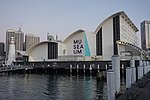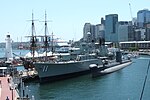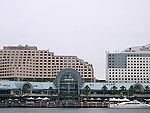USS Canberra (CA-70)

USS Canberra (CA-70/CAG-2) was a Baltimore-class cruiser and later a Boston-class guided missile cruiser of the United States Navy (USN). Originally to be named USS Pittsburgh, the ship was renamed before launch to honor the Australian cruiser HMAS Canberra sunk during the Battle of Savo Island. Canberra was the first USN warship named after a foreign capital city, and one of the few named after a foreign warship not captured in battle with a USN ship. The ship entered service in 1943 and served in the Pacific theater of World War II until she was torpedoed during the Aerial Battle of Taiwan-Okinawa and forced to return to the United States for repairs. Placed in reserve after the war, Canberra was selected for conversion into the second guided-missile carrying warship in the USN fleet. Following the conversion, she was host to the ceremony for selecting the Unknown Soldier representing World War II in 1958, undertook an eight-month round-the-world cruise in 1960, participated in the Cuban Missile Crisis naval blockade in 1962, and was deployed to the Vietnam War on five occasions between 1965 and 1969.
Excerpt from the Wikipedia article USS Canberra (CA-70) (License: CC BY-SA 3.0, Authors, Images).USS Canberra (CA-70)
Waterfront Promenade, Sydney Sydney
Geographical coordinates (GPS) Address Website Nearby Places Show on map
Geographical coordinates (GPS)
| Latitude | Longitude |
|---|---|
| N -33.8694298 ° | E 151.1986428 ° |
Address
Australian National Maritime Museum
Waterfront Promenade
2000 Sydney, Sydney
New South Wales, Australia
Open on Google Maps











